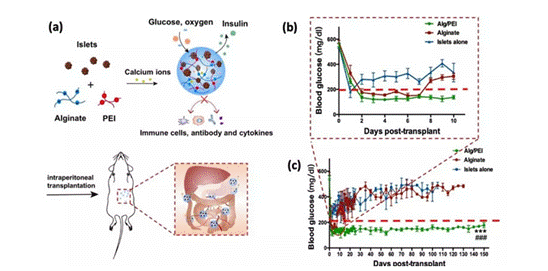An anti-biofouling balanced charged hydrogel that can serve as an excellent immunoprotective material for islet transplantation therapy is developed by Tianjin University research group led by Prof. Zhang Lei, posing a promising treatment for 30 million patients worldwide suffering from type 1 diabetes mellitus(T1DM).
Multiple daily exogenous insulin injections are the common treatment for patients with T1DM, but it inevitably brings a lot of pain. Moreover, this method cannot dynamically respond the changes of blood glucose concentrations and may cause serious complications. Transplantation of encapsulated healthy islets proves to be a promising strategy since it may achieve dynamical blood glucose control and insulin independence. However, human body immune system will immediately recognize and isolate the transplanted islets, limiting its long-term clinical therapeutic efficacy. Moreover, currently very limited biomaterials can completely avoid the foreign body reaction (FBR). Thus, the development of an ideal encapsulating biomaterial that can evadein vivoimmune recognition and FBR is still the greatest challenge.
Based on the balanced charge strategy,Prof. Zhang’s team developed a novel anti-biofouling hydrogel that enables high efficient islet encapsulation,in vivoimmune evasion, and rapid and long-term blood glucose control. Afterintraperitoneal transplantation of islets encapsulated in this hydrogel, 100% of the recipient mice could rapidly recover tonormal blood glucose levelwithin 2 days and remain stable for at least 150 days without any immunosuppression treatment.
“The new type of balanced charged anti-biofoulinghydrogel is low-cost and has a great potential to be widely used in biomedical and health field, including cell therapy and tissue engineering.” Prof. Zhang said.
The research results have been published in the latest issue of Advanced Function Materials and applied for utility patent in China.

Fig. (a)Schematic demonstrating the encapsulation of islets using a balanced charged hydrogel for immunoprotection and dynamic insulin secretion after intraperitoneal transplantation in STZ-induced diabetic mice. (b)Nonfasted blood glucose level of recipient mice in the first 10 days after transplantation.(c) The long-term nonfasted blood glucose level of recipient mice up to 150 days after transplantation.
By Eva Yin & Zhang Lei
Editors: Doris Harrington






